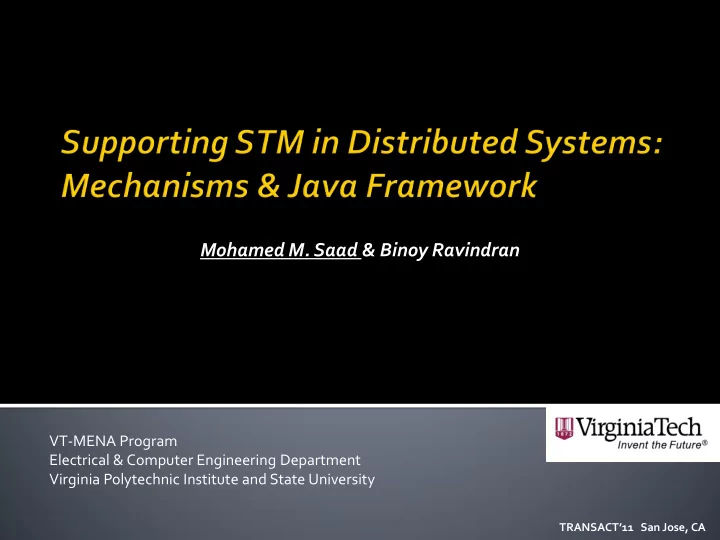

Mohamed M. Saad & Binoy Ravindran VT-MENA Program Electrical & Computer Engineering Department Virginia Polytechnic Institute and State University TRANSACT’11 San Jose, CA
An operation (or set of operations) appears to the rest of the system to occur instantaneously Example (Money Transfer): …… …… from = from - amount to = to + amount …… ……
Y Example (Money Transfer): …… A B …… account1.lock() account2.lock() X from = from - amount to = to + amount account1.unlock() Deadloc Deadlock account2.unlock() Liv Liveloc elock …… Star Starva vation tion …… Prior Priorit ity y In Inver ersion sion Non Non-composa composable ble Non Non-scala scalable on multipr ble on multiprocess ocessor ors
Multiple nodes Message passing links Objects are distributed over the network Distributed transactions !!!
Current Approaches Remote Procedure Calls (RPC) ▪ e.g. Java TM RMI Distributed Shared Memory ▪ Home based ▪ Directory based Not designed Not designed for or suppor supporting ting atomicit tomicity ▪ Replication Inh Inherit erited ed dr drawbac awbacks ks of of loc locks ks High overhead High erhead Requ equir ires es signif significan icant t cod code c e chan hanges ges Extending Transactional Memory concepts to Distributed Environment
Complex systems implies the need for distributed environment Complexity of current programming model Distributed deadlock, race conditions, … . High performance transactions The lack for D-STM framework & testbed suit Locality … Locality … Locality Towards Hybrid execution model (Hybrid Flow)
We present HyFlow , a distributed STM framework with modular design, and pluggable interface. Testbed suit as a distributed set of benchmarks Simple programming model based on code generation and annotation for accessing remote & atomic code We propose two mechanisms for dataflow & control-flow D-STM
Distributed STM Java framework , with pluggable support for: directory lookup protocols, transactional synchronization and recovery mechanisms, contention management policies, cache coherence protocols, and network communication protocols. Employ the correct execution model (data or control or hybrid) Focus more on business logic & less on remote access (stubs, MPI, … ) or transactional semantics (concurrency)
Dataflow model Objects are mobile, transactions permanent at their invoked nodes A X B Y C
Control-flow model Immobile objects with mobile transactions A X B Y C
Hybrid model Automatically select suitable flow (data/control) according to access patterns and transaction costs/overhead A X B Y C
Changing ownership Copy / Replica Proxy
Write ExclusiveAccess & added to write set W R S Read W SharedAccess & added to read set R S Shared SharedAccess & not added to read set Should be promoted at commit time to read or write Useful for data structure implementations Careful usage to preserve linearizability or opacity
No special compiler, or underlying virtual machine modifications Uses Annotations @........ Employs Instrumentation for code generation at load time Locates objects by “ Locators ” with three modes; shared, read & write Flat nesting model support
class BankAccount{ int amount; String id; BankAccount( String id){ this.id = id; class Transaction{ } @atomic { retries=50, timeout=1000 } @remote void transfer( String acc1, String acc2, int amount){ void getId(){ return this.id; } Locator<BankAccount> locator = HyFlow.getLocator(); BankAccount account1 = locator .locate(acc1); @atomic BankAccount account2= locator .locate(acc2); @remote account1.withdraw(amount); void deposit( int dollars){ account2.deposit(amount); amount = amount + dollars; } } } @atomic @remote void withdraw( int dollars){ amount = amount – dollars; } }
Dataflow algorithm (mobile objects/immobile transactions) Rationale Every object associated with a versioned lock Every node has a local clock (version generator) Transaction reads clock when it starts TC Clocks ▪ Objects requests are piggybacked with node clock ▪ If recipient found incoming clock > local clock → advance its clock ▪ Transaction Forwarding mechanism At commit time all object versions must be < TC
Control-flow algorithm (immobile objects/mobile transactions) Rationale Transaction moves between nodes, while objects are immobile Each node has a portion of the write and read sets Transaction metadata are detached from the transaction context Distributed validation at commit time using voting mechanism Implementation Undo-log & Write buffer variants D2PC voting protocol
120 nodes, 1.9 GHz each, 0.5~1 ms end-to-end delay 8 threads per node (1000 concurrent transactions) 50-200 sequential transactions ≈ 4 millions transactions 5% confidence interval (variance) Use 5 distributed benchmarks: Bank, Loan, Vacation, Linked List & Binary Search Tree.
TFA Performance
Snake TM Performance
Locality (Dataflow vs. Control-flow) Bank Benchmark
We presented HyFlow, a high performance pluggable, distributed STM that supports both dataflow and control flow distributed transactional execution Our experiments show that HyFlow outperforms other distributed concurrency control models The dataflow model scales well with increasing number of calls per object. It moves objects toward geographically-close nodes that access them frequently, reducing communication costs Control flow is beneficial under non-frequent object calls or calls to objects with large sizes We introduce Hybrid flow model analysis to understand the tradeoff between control-flow and data flow execution models
Reduce retries overhead using schedulers Hybrid flow execution model Support closed & open nesting in distributed transactions Multi-versioned objects approach
Please visit us at www.hyflow.org
Recommend
More recommend